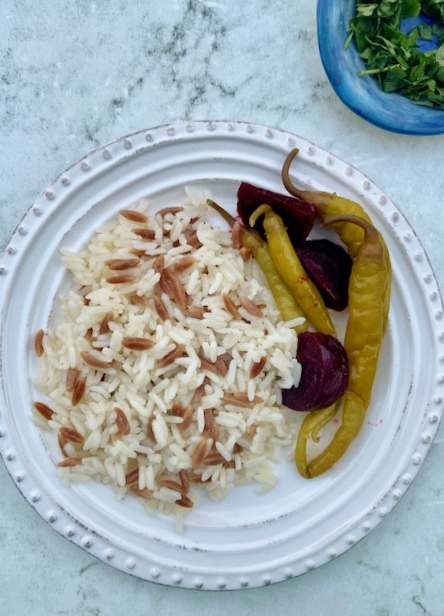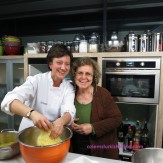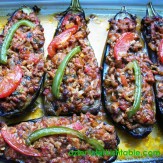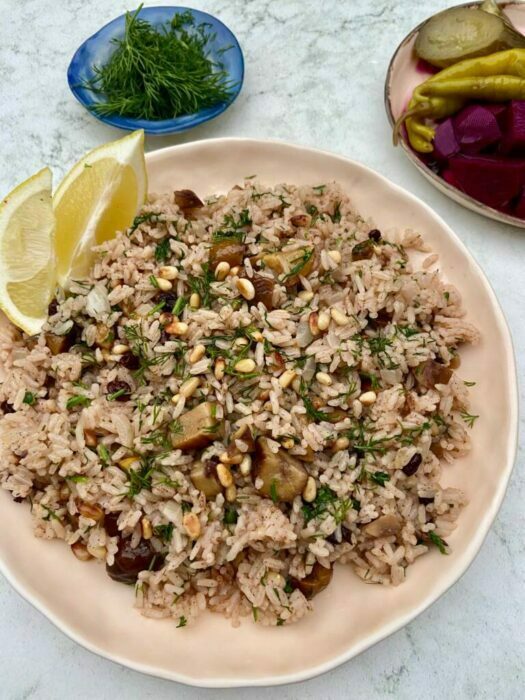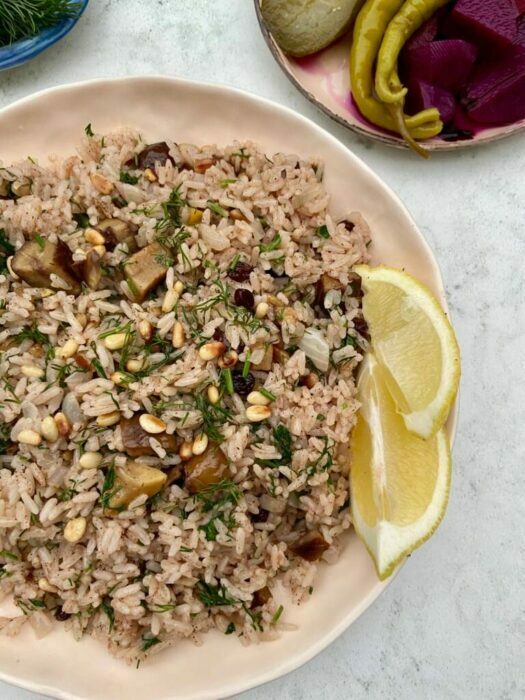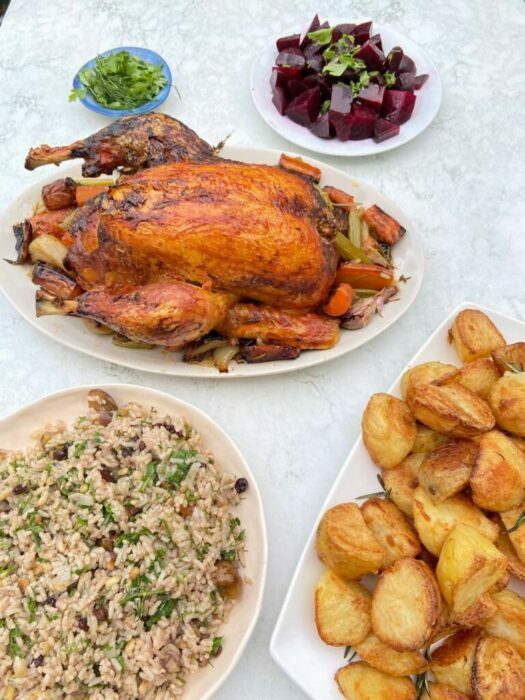
My dear belated dad Orhan, absolutely loved his roast chicken, Firin Tavuk, with our traditional rice with currants (kus uzumu) stuffing, Ic Pilav. I have recreated this special recipe recently, and we greatly enjoyed it with friends. I used Jamie Oliver’s roast chicken recipe as a base and adapted to my Turkish style roast with our additions.
Towards to end of the roasting, we traditionally glaze the chicken with a mixture of tomato paste, yoghurt and olive oil; this gives a lovely colour and taste to the chicken. The rice that we use to stuff the chicken is partially cooked – you can prep this ahead of time.
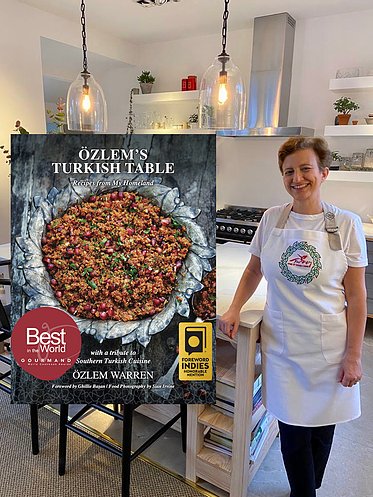
I hope you enjoy my mother’s roast chicken recipe, firin tavuk, which would appear at special family meals as well as at New Year’s Eve on our table. If you wish, you can stuff your turkey with this fragrant rice this way too. Muhammara, my mother’s walnut and red pepper paste dip, as well as zingy Shepherd’s Salad always accompanied our roast, if you like to include at your festive table – both recipes are included at my cookery table, Ozlem’s Turkish Table, as well as the Ic Pilav, Herby rice with pine nuts, currants, with addition of lamb liver (just omit lamb liver for a vegetarian option). My baked beetroot salad with pomegranate molasses also makes a lovely accompaniment to this festive dish. If you live in the USA, Canada or Mexico, there is now lower shipping rates for hardback copies of Ozlem’s Turkish Table at this link.
My very best wishes to you all for the festive season, Afiyet Olsun,
Ozlem
Turkish style roast chicken with rice and currants stuffing – Ic Pilavli Firin Tavuk
Author: Ozlem Warren
Recipe type: Turkish style roast chicken
Cuisine: Turkish cuisine
- For the roast chicken:
- 1.9kg/4lb 5oz free range chicken
- 650g/1lb 6oz carrots
- 2 medium onions
- 1 bulb of garlic
- 1 lemon, cut in half
- 60ml/4tbsp olive oil
- Handful of sprigs of fresh thyme and rosemary
- For the 2nd stage chicken marinade:
- 10ml/2tsp double concentrated tomato paste
- 15ml/1tbsp whole milk yoghurt
- 15ml/1tbsp olive oil
- Salt and ground black pepper to taste
- For the Rice pilaf with chestnuts, pine nuts and currants:
- 170g/6oz cooked chestnuts, chopped into small bite size pieces
- 30ml/2 tablespoons olive oil
- 15ml/1 tablespoon butter
- 30ml/2 tablespoons currants
- 45ml/3 tablespoons pine nuts
- 1 medium onion, finely chopped
- 10ml/2 teaspoons ground cinnamon (add a little more if you like cinnamon)
- 350g/12oz long grain rice, rinsed and drained
- 750ml/1¼ pints hot water (500ml hot water for partial cooking first)
- 1 small bunch of flat leaf parsley, finely chopped
- 1 small bunch of dill, finely chopped
- Sea salt and ground black pepper
- Wedges of lemon to serve
- For the roast potatoes:
- 1.5kg/3lb 5oz Maris Piper potatoes
- 45ml/3tbsp olive oil
- Salt and pepper to taste
- First prepare your fragrant rice. We will be partially cooking the rice to stuff into the chicken. Soak the currants in warm water for about 15 minutes. Then drain and set aside.
- Heat the butter and the olive oil in a heavy, medium size pan over a medium heat. Stir in the onion and cook for about 4-5 minutes, until softened. Stir in the currants, cinnamon and the rinsed rice, combine well for a minute. Season with salt and ground black pepper. Pour in the 500ml hot water and bring to the boil. Then lower the heat, cover the pan and simmer gently for 7- 8 minutes or until all the liquid have been absorbed. Our partially cooked rice with currants is ready. You can make your partially cooked rice a day ahead of time and keep covered in the fridge.
- Remove the chicken from the fridge 30 minutes before cooking and bring to the room temperature. Preheat the fan oven to 200C/400F.
- Wash and coarsely chop the vegetables, there is no need to peel the carrots. Break the garlic bulb into cloves and leave them unpeeled. Spread the prepared vegetables on a large bowl, drizzle 30ml/2tbsp olive oil, season with sea salt and pepper and sprigs of rosemary and thyme. Rub and combine all with the vegetables. Leave this bowl aside – to be combined with the chicken later.
- Place the chicken on a large roasting tray. Drizzle the chicken with 30ml/2tbsp olive oil and season well with sea salt and ground black pepper and rub all round the bird.
- Place half of the lemon inside the chicken’s cavity. Then carefully spoon 270g/9oz of partially cooked rice inside the chicken’s cavity. Take care not to over stuff, so the rice won’t get mushy. Insert the other half of the lemon to close chicken’s cavity. Roast for 1 hour at preheated fan oven at 200C/400F.
- Now is the time to prepare your roast potatoes, if you plan to have them. Make sure to get them into the oven for the last 45 minutes of cooking. Peel the potatoes and quarter the large ones and cut the medium ones in half, so they are all roughly even size. Place them on a large pot, sprinkle over salt. Cover with hot water and par boil for 7 -8 minutes. Then drain in a colander and leave to steal dry for 2 -3 minutes.
- After 1 hour of roasting, take the chicken out of the oven and spread your prepared vegetables around the chicken to roast together another 30 minutes.
- Place the potatoes into a large tray, drizzle with 45ml/3tbsp olive oil and season with sea salt and ground black pepper. Coat and combine well and roast in the oven for 40-45 minutes, timing with the roast chicken.
- Now prepare your Turkish style marinade to coat the chicken, for the 2nd stage of marinade; in a small bowl, combine 2 tsp tomato paste, 1tbsp olive oil and 1tbsp whole milk yoghurt, season with sea salt and black pepper, combine well. After the 1 hour 30 minutes of chicken being roasted, take the chicken tray out and brush this marinade all over the chicken. Return the chicken tray back to the oven for a further 15 minutes of roasting; by the end of this period, the vegetables around the chicken should be nicely roasted and the marinate will give a lovely colour to the chicken, as well as taste. When the chicken is cooked (to check, cut into the chicken; if the juices run clear, then the chicken is fully cooked) take the tray out of the oven and transfer the chicken to a board to rest for 10 minutes or so. Cover the chicken and roasted vegetables with foil to keep warm.
- While the chicken is in the oven for the final stage, finish your partially cooked festive rice. On a medium to large pot, drizzle 1 tbsp olive oil and stir in the pine nuts; stir and sauté for 2 minutes over medium heat - as they begin to turn golden, stir in the chopped chestnuts and partially cooked rice and combine well. Pour in the remaining 250ml / 9fl oz hot water over, season with salt and black pepper, combine well. Then lower the heat, cover the pan and simmer gently 5-6 minutes or until all the liquid have been absorbed. Turn off the heat; cover the pan with a clean kitchen towel and place the lid back on tightly. Leave to steam for 10 minutes. Just before serving, stir in the chopped parsley and dill and combine gently.
- Place your festive Ic Pilav on a large serving plate, and your roast potatoes on another serving place. Serve your Turkish style roast, Firin Tavuk, with vegetables around. Muhammara, my mother’s walnut and red pepper paste dip, as well as zingy Shepherd Salad always accompanied our roast, if you like to include at your festive table too.
3.5.3251
